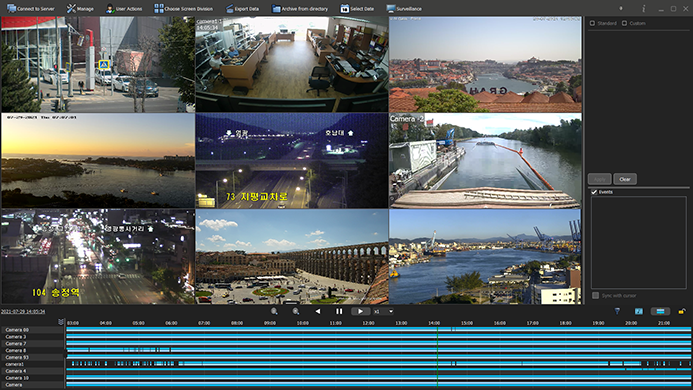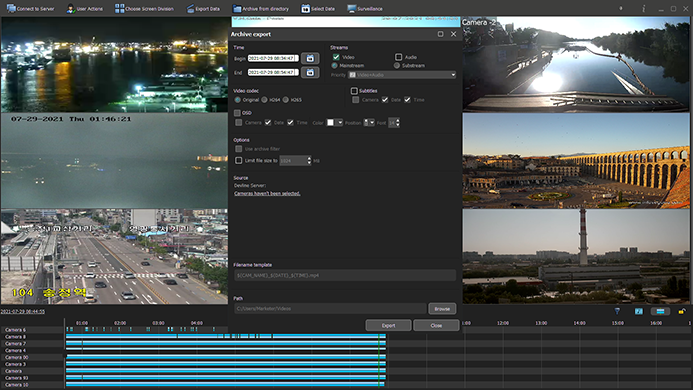Surveillance system. Playback

The Playback menu is intended for viewing frames and exporting already recorded information in a convenient format.
Video analytics in the archive. Line can filter archive records by detection, object size, direction of motion and face detection. When searching, the frame is split into 64 areas.
Line users can organise camera records by groups on different drives. This function makes it possible to set camera recording priority and determine the different archive depth for each camera or group of cameras. There is also an option to duplicate the archive.
|
For user convenience, a special MyVMS app has been developed for Android and iOS smartphones. The application’s interface is identical to Observer in terms of functions, including the ability to manage the server. You can view the archive and export video on your mobile phone. |
 |
The multi-server function provides the ability to work simultaneously with several Line servers that are remote from each other. The process for viewing the archive is synchronized for all servers. This solution is often used in companies and offices that have several servers and all the information flows into a single monitoring and control centre.
The function has been implemented where it is possible to view recorded information at the same time from all available server cameras that were recording.
The archive can be filtered by defined events. You just need to enable one of the video analytics filters before starting to record. This option will save the operator's time and increase search efficiency.

Export the archive in a convenient video recording format. The software allows you to upload any piece of recorded information (from several minutes to several days). Video can be exported together with audio from a microphone.
The video is exported using the codec used to record from the camera directly to the MP4 container. This will make it possible to view the archive in different systems without any additional video file conversion at the same speed as the export. You can also remotely export the archive in a convenient video recording format.
The following is available to Line users:
- export the video archive from several cameras with the same settings at the same time;
- export according to video analytics filters;
- export subtitles to the same container with video (camera, date, time);
- priority of played records (video, audio, video and audio);
- option to limit the size of the exported file;
- editable export file name templates.
Any recording can be separated into frames for detailed archive analysis.

Viewing the Archive from a Folder. This function enables viewing of an archive recorded on another server. In the interface, it will appear as though the archive was recorded on the current server with the capability of viewing the timeline, archive tags and analytics searches. Archive reading is available from the hard disk of another server, USB flash-drive, or it could be data copied from different servers.
Writing to a Network Directory. It is possible to record an archive not on local drives connected to the server or registry, but on a network drive, NAS, and network folder.
|
Convenient archive management. When viewing the archive, you can increase the timescale to several minutes or decrease it to several days of recorded information. You can easily search for the required timescale segment by moving the mouse while keeping the key pressed. Pause the video while the archive is playing and scroll to find a more precise moment and select a better frame. |
 |
The main archive management functions are duplicated on the keyboard. Use the space bar (pause), up and down arrows (increase and decrease playback speed), right and left arrows (go forward or backward) and the mouse wheel (to view by frames).





